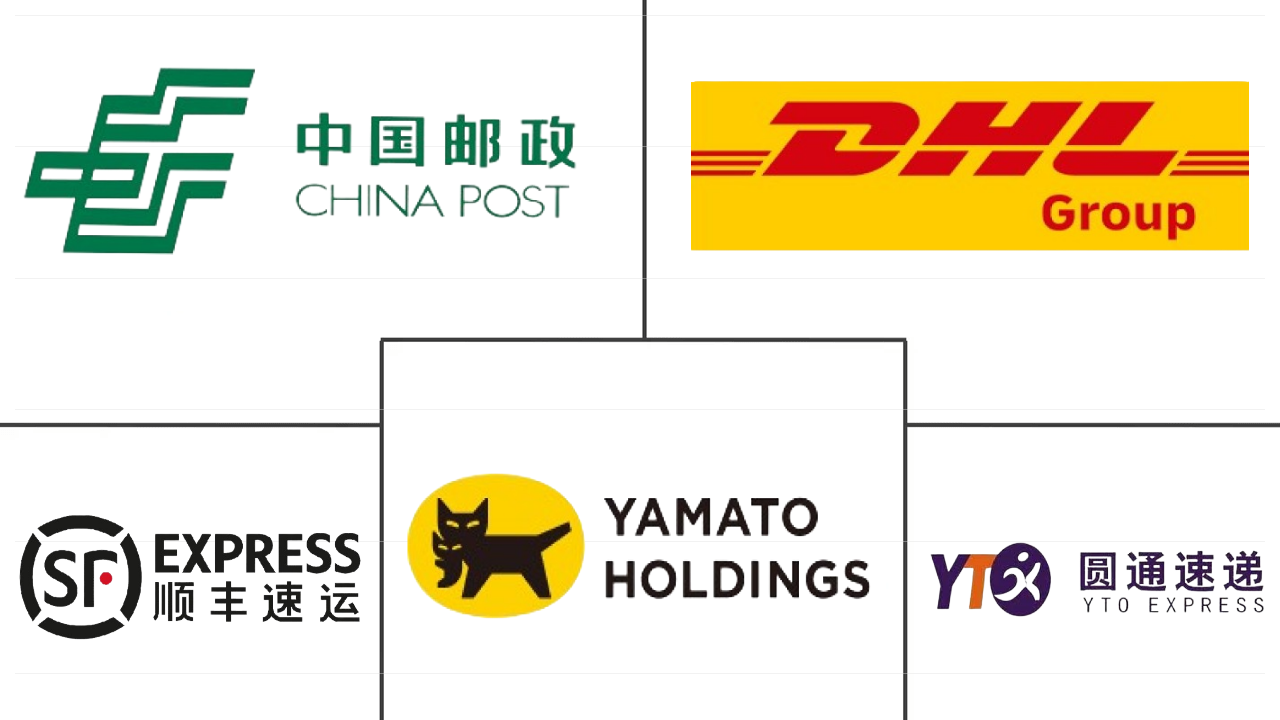Market Size of asia pacific courier, express, and parcel (cep) Industry
|
|
Study Period | 2017 - 2030 |
|
|
Market Size (2024) | USD 225.82 Billion |
|
|
Market Size (2030) | USD 337.54 Billion |
|
|
Largest Share by Destination | Domestic |
|
|
CAGR (2024 - 2030) | 6.93 % |
|
|
Largest Share by Country | China |
Major Players |
||

|
||
|
*Disclaimer: Major Players sorted in no particular order |
Asia Pacific Courier, Express, and Parcel (CEP) Market Analysis
The Asia Pacific Courier, Express, and Parcel (CEP) Market size is estimated at 225.82 billion USD in 2024, and is expected to reach 337.54 billion USD by 2030, growing at a CAGR of 6.93% during the forecast period (2024-2030).
225.82 Billion
Market Size in 2024 (USD)
337.54 Billion
Market Size in 2030 (USD)
5.72 %
CAGR (2017-2023)
6.93 %
CAGR (2024-2030)
Fastest Growing Market by Speed of Delivery
7.63 %
Projected CAGR, Express, 2024-2030
Leading e-commerce and CEP market players are developing technologically advanced facilities to facilitate a strong express delivery supply chain.
Fastest Growing Market by Model
9.05 %
Projected CAGR, Business-to-Consumer (B2C), 2024-2030
Various expansions and collaborations exclusive to the B2C segment are aimed to ensure smooth logistics operations for merchants and enhance the overall customer shopping experience.
Largest Market by Shipment Weight
59.32 %
value share, Light Weight Shipments, 2023
The delivery demand for groceries and pharmaceutical products and the emergence of quick commerce in the region are the major growth drivers of the segment.
Largest Market by End User Industry
34.61 %
value share, E-Commerce, 2023
Technologies like cloud computing, smartphone apps, and social networking have increased the demand for delivery services, thus boosting the growth of e-commerce logistics.
First Leading Market Player
11.52 %
market share, SF Express (KEX-SF), 2022

SF Express provides international express services in 20 major Asia-Pacific countries. It also offers parcel pickup and delivery services across major locations within Asia-Pacific.
Rising international trade largely owing to cross-border e-commerce boosts the market's growth
- The manufacturing sector is the major demand generator of the CEP market. In 2020, 15 jurisdictions, including Australia, China, Japan, New Zealand, and the Republic of Korea, signed the Regional Comprehensive Economic Partnership (RCEP) with the Association of Southeast Asian Nations, making it the world’s largest free trade agreement, which came into force in 2022. Other aspects, such as rapid urbanization and significant growth in the e-commerce sector, drive the CEP market growth, wherein users in Asia are expected to touch 3.1 billion by 2025. India and Pakistan are also expected to witness significant growth in e-commerce in the projected period, which would boost the CEP market.
- China dominates the Asia-Pacific courier market, owing to factors such as the presence of many courier service suppliers and providers and the increasing growth of import and export activities. Around 16,681 courier businesses were operating in the country in 2021. These showcase the presence of foreign courier companies that had started gathering a larger market share during the historic period. In addition, In 2021, China's cross-border e-commerce import and export scale increased by 18.6% YoY as demand in various regions and countries rose post-pandemic. During the Double 11 shopping festival in 2021, a total of 696 million parcels were shipped, an increase of 18.2% over the previous year.
- E-commerce is one of the major factors driving the market growth for CEP. The fashion segment in Asia generated the largest revenue in the e-commerce market at over USD 356 billion. The revenue from the fashion segment is further projected to touch USD 582 billion by 2024, owing to increasing demand and a rise in e-commerce, which is expected to drive the CEP market demand significantly.
Indian logistics companies target 2.5 billion DTC shipments by 2030 due to booming e-commerce
- China the world's largest construction market, is projected to grow at an average annual rate of 8.6% during 2022-2030. In 2022, the construction sector accounted for over 6.5% of the country's GDP. The output value of the construction sector increased by 6.05% in 2022 compared to the previous year, reaching CNY 31.2 trillion (USD 4.53 billion). The top construction companies in China based on revenue are China Railway Construction Corporation Limited, China State Construction Engineering, and China Dalian International Economic and Technical Cooperation Group, with revenues of USD 147.27 billion, and USD 273 billion.
- By 2030, modern logistics companies are expected to be responsible for delivering 2.5 billion shipments directly to consumers (D2C). In 2022, the e-commerce market generated a total revenue of USD 60.73 billion, experiencing a YoY growth of 3.62%. Among the e-commerce players in India, Amazon.com holds the largest market share, accounting for 48%, with a total revenue of USD 5.56 billion in 2022. Flipkart ranks as the second-largest e-commerce company, generating a total revenue of USD 6.175 billion in 2022.
- The global medical courier service market is projected to reach a value of USD 7.1 billion by 2027, with a CAGR of 5.5% during 2022-2027. Asia-Pacific contributes over 25% to this market. Australia recently introduced a delivery app called Medmate, which offers a home delivery service for prescription medicine. Medmate has partnered with on-demand delivery company DoorDash, allowing for the safe delivery of prescription medicine within an hour of electronically presenting the prescription in most metropolitan areas of Australia.
Asia Pacific Courier, Express, and Parcel (CEP) Industry Segmentation
Domestic, International are covered as segments by Destination. Express, Non-Express are covered as segments by Speed Of Delivery. Business-to-Business (B2B), Business-to-Consumer (B2C), Consumer-to-Consumer (C2C) are covered as segments by Model. Heavy Weight Shipments, Light Weight Shipments, Medium Weight Shipments are covered as segments by Shipment Weight. Air, Road, Others are covered as segments by Mode Of Transport. E-Commerce, Financial Services (BFSI), Healthcare, Manufacturing, Primary Industry, Wholesale and Retail Trade (Offline), Others are covered as segments by End User Industry. Australia, China, India, Indonesia, Japan, Malaysia, Pakistan, Philippines, Thailand, Vietnam are covered as segments by Country.
- The manufacturing sector is the major demand generator of the CEP market. In 2020, 15 jurisdictions, including Australia, China, Japan, New Zealand, and the Republic of Korea, signed the Regional Comprehensive Economic Partnership (RCEP) with the Association of Southeast Asian Nations, making it the world’s largest free trade agreement, which came into force in 2022. Other aspects, such as rapid urbanization and significant growth in the e-commerce sector, drive the CEP market growth, wherein users in Asia are expected to touch 3.1 billion by 2025. India and Pakistan are also expected to witness significant growth in e-commerce in the projected period, which would boost the CEP market.
- China dominates the Asia-Pacific courier market, owing to factors such as the presence of many courier service suppliers and providers and the increasing growth of import and export activities. Around 16,681 courier businesses were operating in the country in 2021. These showcase the presence of foreign courier companies that had started gathering a larger market share during the historic period. In addition, In 2021, China's cross-border e-commerce import and export scale increased by 18.6% YoY as demand in various regions and countries rose post-pandemic. During the Double 11 shopping festival in 2021, a total of 696 million parcels were shipped, an increase of 18.2% over the previous year.
- E-commerce is one of the major factors driving the market growth for CEP. The fashion segment in Asia generated the largest revenue in the e-commerce market at over USD 356 billion. The revenue from the fashion segment is further projected to touch USD 582 billion by 2024, owing to increasing demand and a rise in e-commerce, which is expected to drive the CEP market demand significantly.
| Destination | |
| Domestic | |
| International |
| Speed Of Delivery | |
| Express | |
| Non-Express |
| Model | |
| Business-to-Business (B2B) | |
| Business-to-Consumer (B2C) | |
| Consumer-to-Consumer (C2C) |
| Shipment Weight | |
| Heavy Weight Shipments | |
| Light Weight Shipments | |
| Medium Weight Shipments |
| Mode Of Transport | |
| Air | |
| Road | |
| Others |
| End User Industry | |
| E-Commerce | |
| Financial Services (BFSI) | |
| Healthcare | |
| Manufacturing | |
| Primary Industry | |
| Wholesale and Retail Trade (Offline) | |
| Others |
| Country | |
| Australia | |
| China | |
| India | |
| Indonesia | |
| Japan | |
| Malaysia | |
| Pakistan | |
| Philippines | |
| Thailand | |
| Vietnam | |
| Rest of Asia Pacific |
Asia Pacific Courier, Express, and Parcel (CEP) Market Size Summary
The Asia Pacific Courier, Express, and Parcel (CEP) market is poised for significant growth, driven by factors such as rapid urbanization, the expansion of the e-commerce sector, and the manufacturing industry's demand. The region's strategic economic agreements, like the Regional Comprehensive Economic Partnership (RCEP), have further bolstered trade activities, enhancing the CEP market's expansion. China stands out as a dominant player in this market, supported by a robust network of courier service providers and a surge in import and export activities. The country's e-commerce landscape, particularly in the fashion segment, is a major contributor to market growth, with increasing consumer demand fueling the need for efficient logistics solutions. Additionally, the construction sector's growth in China adds to the demand for CEP services, as modern logistics companies are expected to play a crucial role in facilitating direct-to-consumer deliveries.
The logistics and warehousing sector in the Asia Pacific is undergoing transformative changes, with a focus on innovation and sustainability to meet the rising demand for efficient operations. The region's infrastructure, including the Asian Highway and Trans-Asian Railway, supports seamless connectivity and integration with global trade networks. Despite challenges such as the COVID-19 pandemic and fluctuating oil prices, the CEP market remains resilient, with major players like China Post, DHL Group, and SF Express leading the charge. The market's fragmentation presents opportunities for growth and consolidation, as companies leverage technology and strategic partnerships to enhance their service offerings. As the region continues to recover economically, the CEP market is expected to thrive, driven by the increasing need for reliable and efficient logistics solutions.
Asia Pacific Courier, Express, and Parcel (CEP) Market Size - Table of Contents
-
1. MARKET SEGMENTATION (includes Market Value in USD, Forecasts up to 2030 and analysis of growth prospects)
-
1.1 Destination
-
1.1.1 Domestic
-
1.1.2 International
-
-
1.2 Speed Of Delivery
-
1.2.1 Express
-
1.2.2 Non-Express
-
-
1.3 Model
-
1.3.1 Business-to-Business (B2B)
-
1.3.2 Business-to-Consumer (B2C)
-
1.3.3 Consumer-to-Consumer (C2C)
-
-
1.4 Shipment Weight
-
1.4.1 Heavy Weight Shipments
-
1.4.2 Light Weight Shipments
-
1.4.3 Medium Weight Shipments
-
-
1.5 Mode Of Transport
-
1.5.1 Air
-
1.5.2 Road
-
1.5.3 Others
-
-
1.6 End User Industry
-
1.6.1 E-Commerce
-
1.6.2 Financial Services (BFSI)
-
1.6.3 Healthcare
-
1.6.4 Manufacturing
-
1.6.5 Primary Industry
-
1.6.6 Wholesale and Retail Trade (Offline)
-
1.6.7 Others
-
-
1.7 Country
-
1.7.1 Australia
-
1.7.2 China
-
1.7.3 India
-
1.7.4 Indonesia
-
1.7.5 Japan
-
1.7.6 Malaysia
-
1.7.7 Pakistan
-
1.7.8 Philippines
-
1.7.9 Thailand
-
1.7.10 Vietnam
-
1.7.11 Rest of Asia Pacific
-
-
Asia Pacific Courier, Express, and Parcel (CEP) Market Size FAQs
How big is the Asia Pacific Courier, Express, and Parcel (CEP) Market?
The Asia Pacific Courier, Express, and Parcel (CEP) Market size is expected to reach USD 225.82 billion in 2024 and grow at a CAGR of 6.93% to reach USD 337.54 billion by 2030.
What is the current Asia Pacific Courier, Express, and Parcel (CEP) Market size?
In 2024, the Asia Pacific Courier, Express, and Parcel (CEP) Market size is expected to reach USD 225.82 billion.

